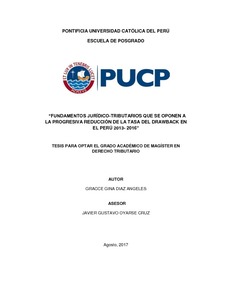| dc.contributor.advisor | Oyarse Cruz, Javier Gustavo | |
| dc.contributor.author | Díaz Ángeles, Gracce Gina | es_ES |
| dc.date.accessioned | 2017-10-12T21:04:59Z | es_ES |
| dc.date.available | 2017-10-12T21:04:59Z | es_ES |
| dc.date.created | 2017 | es_ES |
| dc.date.issued | 2017-10-12 | es_ES |
| dc.identifier.uri | http://hdl.handle.net/20.500.12404/9493 | |
| dc.description.abstract | El Régimen de Restitución Arancelaria denominado Drawback entró en vigencia en el Perú en junio
de 1995 con la publicación del Decreto Supremo N° 104-95-EF. Más de 20 años han trascurrido
desde que nuestro ordenamiento introdujo la posibilidad de obtener la restitución de los derechos
arancelarios que hayan gravado la importación de mercancías que posteriormente fueran
incorporadas en los bienes exportados o, en su defecto, consumidas durante su producción.
Ciertamente, en todos los años que se ha otorgado este beneficio se han suscitado modificaciones
y ajustes en el procedimiento de devolución e incluso en los elementos sustanciales del régimen.
No obstante, ningún cambio afecta tan severa e inminentemente al beneficio como lo hace la
reducción de la tasa de devolución. En ese sentido, si bien se abordarán los elementos conformantes
del régimen centraremos nuestro análisis en el elemento cuantitativo del beneficio y en cómo es
que la reducción del mismo carece de sustento, ello de cara a los resultados generados por esta
política tributaria perniciosa para el productor exportador y en general para economía nacional. En
el presente trabajo de Tesis dilucidaremos si existían razones que sustenten esta política tributaria
que se dejó sentir en los años 2015 y gran parte de 2016, así mismo, se abordará la problemática
vinculada al recorte del beneficio y los efectos de su posible eliminación. A manera de adelanto, le
anticipamos que en las siguientes líneas usted encontrará un postura contraria a la reducción que
operó en el referido periodo, toda vez que consideramos que no existen fundamentos jurídicotributarios
para una medida de esta naturaleza, más aun cuando el contexto internacional en el que
se desenvuelven nuestros productores exportadores les resulta adverso, lo que ciertamente
contribuye a la contracción de las exportaciones de mercancías no tradicionales y a la disminución
de la competitividad de nuestra oferta internacional. | es_ES |
| dc.description.abstract | The Duty Restriction Regime called Drawback begun to be enforced in Peru as of June 1995. On this
date, the Supreme Decree Nº 104-95-EF was published. Over 20 years have passed since our
legislation contemplates the possibility of having a full or partial rebate of the customs duty charged
to the import of goods that are later contained in exported goods, or consumed during their
manufacturing process. Certainly, in all the years that this benefit has been granted to the exporting
producer, there have been adjustments and modifications in the rebate procedure and even on
substantial elements of the regime. Nevertheless, none of these changes affect the benefit so deeply
as the reduction of the rebate rate. In this sense, even though the elements that compose the
regime will be addressed, our analysis focuses on the quantitative element of the benefit, and how
its reduction is unfounded. This with regard to the results generated by this pernicious tax policy for
the exporters and the national economy in general. In the present Thesis we will explain if there are
any reasons that support this tax policy, whose impact was felt on 2015 and during most of 2016.
We will also address the problems related to the reduction of the benefit, and the effects of possibly
eliminating the regime. We would like to let you know beforehand that in the following lines you
will find a posture against the reduction that occurred during the period mentioned above, every
time we consider that there are no legal-tax bases for a measure of this nature, particularly when
the international context in which our exporting producers operate is adverse, which surely has
contributed to the contraction of exports of non-traditional goods, and meant the regress in the
progress made related to our international offer competitiveness. | es_ES |
| dc.language.iso | spa | es_ES |
| dc.publisher | Pontificia Universidad Católica del Perú | es_ES |
| dc.rights | info:eu-repo/semantics/openAccess | es_ES |
| dc.rights.uri | http://creativecommons.org/licenses/by-nc-nd/2.5/pe/ | * |
| dc.subject | Aranceles de aduana--Legislación--Perú | es_ES |
| dc.subject | Derecho aduanero--Perú | es_ES |
| dc.subject | Comercio internacional--América Latina | es_ES |
| dc.title | “Fundamentos jurídico-tributarios que se oponen a la progresiva reducción de la tasa del drawback en el Perú 2013- 2016” | es_ES |
| dc.type | info:eu-repo/semantics/masterThesis | es_ES |
| thesis.degree.name | Magíster en Derecho Tributario | es_ES |
| thesis.degree.level | Maestría | es_ES |
| thesis.degree.grantor | Pontificia Universidad Católica del Perú. Escuela de Posgrado | es_ES |
| thesis.degree.discipline | Derecho Tributario | es_ES |
| renati.discipline | 422277 | es_ES |
| renati.level | https://purl.org/pe-repo/renati/level#maestro | es_ES |
| renati.type | http://purl.org/pe-repo/renati/type#tesis | es_ES |
| dc.publisher.country | PE | es_ES |
| dc.subject.ocde | https://purl.org/pe-repo/ocde/ford#5.05.01 | es_ES |






